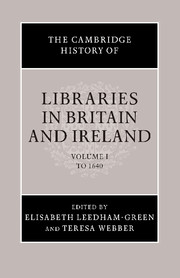Book contents
- Frontmatter
- Introduction
- The physical setting
- Part One The medieval library
- Part Two Reformation, dissolution, new learning
- Part Three Tools of the trade
- 13 Universities and colleges
- 14 Major ecclesiastical libraries: from Reformation to Civil War
- 15 Clerical and parish libraries
- 16 Schools and schoolmasters (to c. 1550)
- 17 School libraries (c. 1540 to 1640)
- 18 Common lawyers and the Inns of Court
- 19 Medical libraries
- 20 Heralds’ libraries
- Part Four Libraries for leisure
- Part Five Organisation and administration
- Select bibliography
- General index
- Index of manuscripts
- References
16 - Schools and schoolmasters (to c. 1550)
from Part Three - Tools of the trade
Published online by Cambridge University Press: 28 March 2008
- Frontmatter
- Introduction
- The physical setting
- Part One The medieval library
- Part Two Reformation, dissolution, new learning
- Part Three Tools of the trade
- 13 Universities and colleges
- 14 Major ecclesiastical libraries: from Reformation to Civil War
- 15 Clerical and parish libraries
- 16 Schools and schoolmasters (to c. 1550)
- 17 School libraries (c. 1540 to 1640)
- 18 Common lawyers and the Inns of Court
- 19 Medical libraries
- 20 Heralds’ libraries
- Part Four Libraries for leisure
- Part Five Organisation and administration
- Select bibliography
- General index
- Index of manuscripts
- References
Summary
Medieval schools relied on books. Mouths and ears were important too – teachers expounded what had to be learnt, pupils repeated it, and both sides engaged in oral questions and answers – but none of this could happen without the support of writings. Teachers needed copies of the texts they taught. Ideally, so did their pupils. A literate child could work alone with a book, while a bookless child depended on its teacher. At advanced levels of study, both teachers and pupils required access to authoritative grammars and dictionaries. Education was therefore a process which attracted books to itself; it also generated them. Masters might engage in copying texts for themselves, and pupils certainly did. The copies and notes of grammar-school boys, in particular, written on quires of parchment or paper, could grow into volumes and be bound, kept, and passed on to other people as primary sources in their own right.
The variety of such books was wide, and increased during the middle ages. At the most elementary level there were tablets containing the alphabet and, perhaps, basic prayers like the Paternoster – tablets of a single page, yet still referred to as ‘books’. Then there were ‘primers’: prayer-books of several leaves containing basic prayers in Latin or English, sometimes beginning with an alphabet as if they were meant to help with learning to read. More advanced prayer-books and liturgical works were used for instruction or reading practice: psalters, antiphonals, and (from the thirteenth century) books of hours. The study of Latin, centred in grammar schools, was facilitated by a range of texts, often written in manuscript anthologies.
- Type
- Chapter
- Information
- The Cambridge History of Libraries in Britain and Ireland , pp. 420 - 434Publisher: Cambridge University PressPrint publication year: 2006



